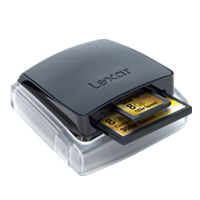The best way to download photos from your digital camera to computer


Of course, not all card readers (or memory cards for that matter) are created equal, but with so many on the market it's hard to tell which one is best. Fortunately, Canadian photojournalist Rob Galbraith has taken a lot of the guesswork out of the equation by testing the transfer speeds of a number of memory card readers using a slew of memory cards. Check out his database of performance results for SD card readers, which he has tested with 47 different SD cards so far. (He also has a CompactFlash reader database here.)
Based on his benchmark testing, unless you use a 4GB or 8GB SanDisk Extreme III 30MB/s Edition card, you'll get the fastest transfers with the Lexar Professional UDMA Dual-Slot USB Reader, which will set you back about $50 and includes both an SD card slot and a CompactFlash slot. If you do have one of the 30MB/s SanDisk Extreme III cards, you'll get the best performance from the SanDisk ImageMate Multi-Card USB 2.0 that's slated to ship for just $19.99 in November 2008 and was designed for faster throughput with SanDisk's Extreme III 30MB/s Edition SDHC cards.
Of course, speed isn't everything. Though it consistently performs slower in Galbraith's tests, I like the Kingston 19-in-1 Media Reader because it supports--you guessed it--19 different card formats (you can get it for just $13 after a $4 instant rebate from Kingston's online shop. I also like the short USB cable that tucks away neatly when not in use (and is not detachable and therefore can't be misplaced) as well as the sliding design that lets you tuck the card slots safely away for storage or travel.
Also check out Galbraith's excellent CompactFlash/SD Performance Database to find out how fast various memory cards perform using Canon, Nikon and recently-added Sony digital SLRs.